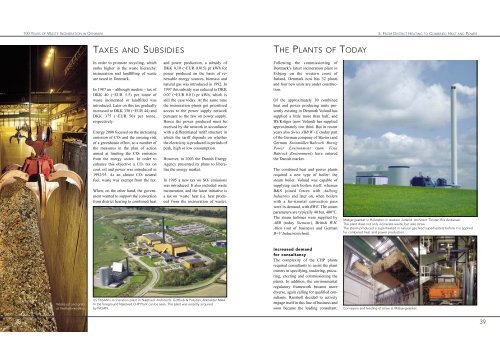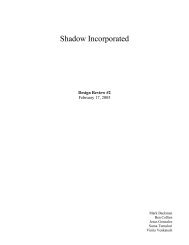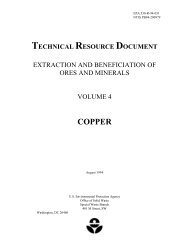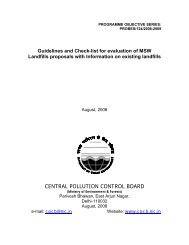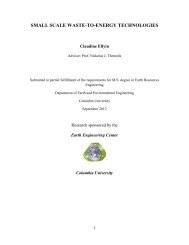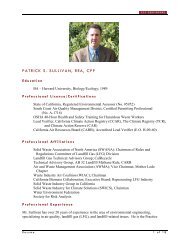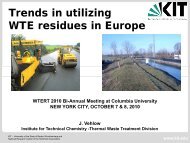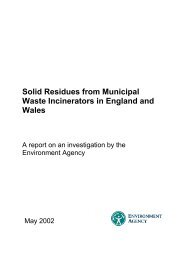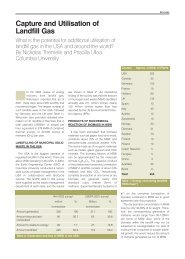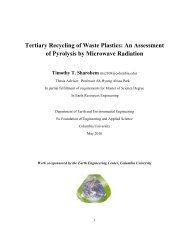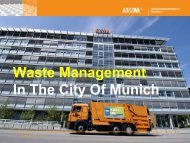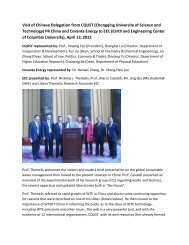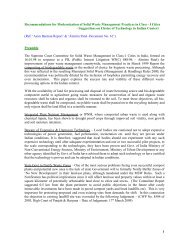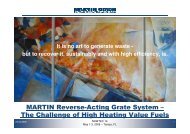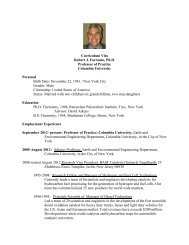100 YEARS OF WASTE INCINERATION IN DENMARK
100 YEARS OF WASTE INCINERATION IN DENMARK
100 YEARS OF WASTE INCINERATION IN DENMARK
You also want an ePaper? Increase the reach of your titles
YUMPU automatically turns print PDFs into web optimized ePapers that Google loves.
<strong>100</strong> <strong>YEARS</strong> <strong>OF</strong> <strong>WASTE</strong> <strong><strong>IN</strong>C<strong>IN</strong>ERATION</strong> <strong>IN</strong> <strong>DENMARK</strong><br />
3. FROM DISTRICT HEAT<strong>IN</strong>G TO COMB<strong>IN</strong>ED HEAT AND POWER<br />
TAXES AND SUBSIDIES<br />
THE PLANTS <strong>OF</strong> TODAY<br />
In order to promote recycling, which<br />
ranks higher in the waste hierarchy,<br />
incineration and landfilling of waste<br />
are taxed in Denmark.<br />
In 1987 an – although modest – tax of<br />
DKK 40 (~EUR 5.5) per tonne of<br />
waste incinerated or landfilled was<br />
introduced. Later on this tax gradually<br />
increased to DKK 330 (~EUR 44) and<br />
DKK 375 (~EUR 50) per tonne,<br />
respectively.<br />
Energy 2000 focused on the increasing<br />
emission of CO2 and the ensuing risk<br />
of a greenhouse effect, so a number of<br />
the measures in the plan of action<br />
aimed at limiting the CO2 emission<br />
from the energy sector. In order to<br />
enhance this objective a CO2 tax on<br />
coal, oil and power was introduced in<br />
1992/93. As an almost CO2 neutral<br />
fuel, waste was exempt from the tax.<br />
When, on the other hand, the government<br />
wanted to support the conversion<br />
from district heating to combined heat<br />
and power production, a subsidy of<br />
DKK 0.10 (~EUR 0.015) pr kWh for<br />
power produced on the basis of renewable<br />
energy sources, biomass and<br />
natural gas was introduced in 1992. In<br />
1997 this subsidy was reduced to DKK<br />
0.07 (~EUR 0.01) pr kWh, which is<br />
still the case today. At the same time<br />
the incineration plants got prioritised<br />
access to the power supply network<br />
pursuant to the law on power supply.<br />
Hence the power produced must be<br />
received by the network in accordance<br />
with a differentiated tariff structure in<br />
which the tariff depends on whether<br />
the electricity is produced in periods of<br />
peak, high or low consumption.<br />
However, in 2003 the Danish Energy<br />
Agency presented its plans to liberalise<br />
the energy market.<br />
In 1995 a new tax on SO2 emissions<br />
was introduced. It also included waste<br />
incineration, and the latest initiative is<br />
a tax on ‘waste’ heat (i.e. heat produced<br />
from the incineration of waste).<br />
Following the commissioning of<br />
Denmark’s latest incineration plant in<br />
Esbjerg on the western coast of<br />
Jutland, Denmark now has 32 plants<br />
and four new units are under construction.<br />
Of the approximately 30 combined<br />
heat and power producing units presently<br />
existing in Denmark Vølund has<br />
supplied a little more than half, and<br />
BS/Krüger (now Vølund) has supplied<br />
approximately one third. But in recent<br />
years also Swiss ABB W+E (today part<br />
of the German company of Martin) and<br />
German Steinmüller/Babcock Borsig<br />
Power Environment (now Fisia<br />
Babcock Environment) have entered<br />
the Danish market.<br />
The combined heat and power plants<br />
required a new type of boiler: the<br />
steam boiler. Vølund was capable of<br />
supplying such boilers itself, whereas<br />
B&S joined forces with Aalborg<br />
Industries and later on, when boilers<br />
with a ho-rizontal convection pass<br />
were in demand, with BWE. The steam<br />
parameters are typically 40 bar, 400°C.<br />
The steam turbines were supplied by<br />
ABB (today Siemens), British W.H.<br />
Allen (out of business) and German<br />
B+V Industrietechnik.<br />
Måbjergværket in Holstebro in western Jutland. Architect: Torsten Riis Andersen.<br />
The plant does not only incinerate waste, but also straw.<br />
The steam produced is superheated in natural gas fired superheaters before it is applied<br />
for combined heat and power production.<br />
Waste pit and grab<br />
at Vestforbrænding<br />
I/S FASAN's incineration plant in Næstved. Architects: Gottlieb & Paludan, Arkitekter MAA.<br />
In the foreground Næstved CHP Plant can be seen. The plant was recently acquired<br />
by FASAN.<br />
Increased demand<br />
for consultancy<br />
The complexity of the CHP plants<br />
required consultants to assist the plant<br />
owners in specifying, tendering, procuring,<br />
erecting and commissioning the<br />
plants. In addition, the environmental<br />
regulatory framework became more<br />
diverse, again calling for qualified consultants.<br />
Rambøll decided to actively<br />
engage itself in this line of business and<br />
soon became the leading consultant.<br />
Conveyors and feeding of straw at Måbjergværket.<br />
38<br />
39


